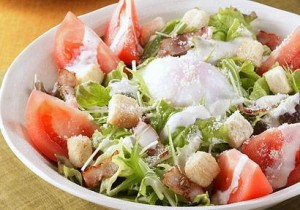 This is a really interesting question because most of us make the assumption that salads are healthy without giving the answer much thought. In fact the word ‘salad’ seems to epitomise health. Whenever I have asked clients to name a healthy food one of the first responses I am used to hearing is ‘salad’.
This is a really interesting question because most of us make the assumption that salads are healthy without giving the answer much thought. In fact the word ‘salad’ seems to epitomise health. Whenever I have asked clients to name a healthy food one of the first responses I am used to hearing is ‘salad’.
One of your 5-a-Day
A salad can be an extremely healthy option and counts towards your 5-a-day. In fact it could possibly count as more than that depending on the portion size because 80g is an adult portion size of fruit and vegetables in the UK. Salad leaves are full of fibre, and fibre helps to lower cholesterol and prevent constipation, which in the longer term could help to prevent bowel disease and cancer.
We should be aiming to eat at least 30g of fibre per day according to the SACN report Carbohydrates and Health, but unfortunately fibre intakes in the UK and US are on average far less than this.
What’s Really in Your Salad?
However do not be fooled into thinking that because you have chosen to eat a salad that you are in fact making a healthy choice. The ingredients chosen to put into a salad, plus the dressing will ultimately determine whether a salad is healthy or not.
Many modern day salads bought in restaurants and eateries may contain a lot more fat, sugar and salt than you would imagine. The quality of the ingredients used will also have an impact on the health benefits.
For example salads containing chicken may contain a lot more fat than you expect. Wang et al. from London Metropolitan University found that modern day chickens contain 20% more fat than they once did, due to modern farming practices and feeding, no longer making chicken a low fat lean option.
A Cobb salad from a large American chain contains 7g of unhealthy fat per portion. Current dietary advice is to decrease the amount of unhealthy fat in our diets because eating too much can raise the level of cholesterol in the blood, which can over time increase the risk of developing heart disease and stroke.
This same salad contains a whopping 3.4g of salt, that’s over half the recommended daily UK intake of 6g for an adult. Too much salt can raise your blood pressure, which again over time puts you at increased risk of developing heart disease and stroke.
Adding croutons to a salad will add nothing but fat, sugar and large amounts of salt. If it’s the crunch factor you are after then why not try cashew or walnuts instead. They contain mono and polyunsaturated fats, fibre and other vitamins and minerals or try slicing up some mange tout.
Make a Healthier Choice
Try to avoid salads that contain processed meat such as bacon, ham or prosciutto as well as chicken as this will only add to your unhealthy fat and salt intake. Why not swap processed meat for cooked prawns.
They are a good source of omega-3, iron (prevents anaemia) and zinc (helps process carbohydrate, fat and protein in the body) and a great source of selenium (plays a role in reproduction).
Consumption of processed meat should be kept to a minimum, so no more than 70g (cooked weight) per day to reduce a possible risk of bowel cancer.
Instead try adding vegetables to your salad leaves rather than meat. Salad vegetables are generally cheaper to buy than meat and anything left over can be used in sandwiches, wraps, flat breads or rolls for lunches.
The wonderful thing about salad is that it is so versatile and need not be expensive to make. Adding tomatoes, peppers, sliced (fresh rather than jarred) beetroot and grated carrots can increase antioxidant intakes of vitamin C, lycopene, and beta-carotene.
Avocados are a fabulous source of good fats, which can in fact help to reduce cholesterol. Cucumber is another great source of fibre and water as is celery and sugar snap peas.
Artichoke hearts in a jar can add texture and flavour and will sit in the fridge to be used in other recipes, while beans, such as kidney and butter beans or chick-peas are a valuable source of vegetable protein and will help to make you feel fuller for longer.
Obviously you do not need to add all of these ingredients at once, it’s more about picking and choosing what you fancy and how simple or fancy you want it to be.
Dress it Lightly
The last thing to consider when preparing or buying a salad is what to dress it in? Are all of these fancy dressings that are on the market really necessary and have you ever bothered to find out what they actually contain?
A well known American chain’s Avocado Lime Ranch Dressing contains 32g of fat 5g of which is saturated fat and 1.3g of salt, so not at all healthy and a long ingredients list with long chemical names which include additives and preservatives. Remember if a product is to sit on a shelf for a few months something has got to stop it from going off. Most other dressings are typically high in fat and salt.
For a dressing that’s low in fat, sugar and salt and contains no additives or preservatives try two tablespoonfuls of extra virgin olive oil or cold-pressed rapeseed oil (both mono-unsaturates and good for your heart), a drizzle of good quality balsamic vinegar, a squeeze of lemon juice and a pinch of cracked black pepper.
This works just as well as those expensive salad dressings.
Or if you are in a restaurant hold the dressing.
Honestly the salad will probably taste just as good without it.
So to come back to the original question is your salad healthy? That really depends upon what you choose to put into it and on it.
Do you constantly suffer from bloating, gas or indigestion when you eat salads or other healthy foods?
If yes, you could be suffering from digestive issues, go to the next page and watch the 3 tips to reverse these digestive-related issues –
About the Author:
 Sonya Kaila graduated from Queen Margaret University with a BSc Nutrition in 2009 and went to work as a Nutritionist with a third sector organisation in Edinburgh trying to tackle health inequalities and food poverty in the city. Part of her role was to educate people into making healthier food choices in order to reduce their likelihood of developing disease later in life and also organising and writing health promotion events, health promotion literature including posters and leaflets and writing articles for the media.
Sonya Kaila graduated from Queen Margaret University with a BSc Nutrition in 2009 and went to work as a Nutritionist with a third sector organisation in Edinburgh trying to tackle health inequalities and food poverty in the city. Part of her role was to educate people into making healthier food choices in order to reduce their likelihood of developing disease later in life and also organising and writing health promotion events, health promotion literature including posters and leaflets and writing articles for the media.
Sonya lives outside of Edinburgh with her two daughters Rhea and Amelia, and enjoys everything food related, pilates and gardening.
Which wonderful friends in your life would appreciate learning about making their salads healthy?
Please help them by sharing this eye-opening article with each of them using any of the social media and email buttons below.


Leave a Reply